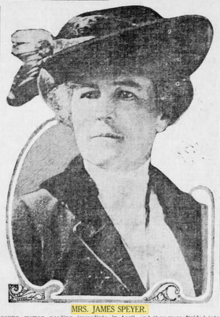Ellin Prince Speyer
Ellin Leslie Prince Lowery Speyer (October 14, 1849 - February 23, 1921) was a New York City philanthropist.[1]

Early life
Ellin Leslie Prince was born on October 14, 1849, in Lowell, Massachusetts, the daughter of John Dyneley Prince and Mary Travers Prince. Her grandfather was also John Dyneley Prince (1779–1860), and a third John Dyneley Prince (1868–1945) was her nephew. Ellin was orphaned as a child, and raised by an uncle, lawyer William Riddle Travers, in New York City.[1]
Career
Ellin Prince took an early interest in hospital charities, helping to found the Hospital Saturday and Sunday Association in 1881, and the New York Skin and Cancer Hospital in 1886.[1] Beginning in 1907 she organized an annual "work horse parade" in New York City, to highlight best practices in the treatment of working horses in the city.[2][3][4] In 1914, as president of the Women's League for Animals,[5] she established the Hospital of the New York Women's League for Animals.[2] During World War I she chaired the mayor's committee responsible for recruiting nurses for overseas work.[1]
Ellin Prince co-founded the "Irene Club" for working girls in 1883. She raised funds for the New York League of Women Workers and the Working Girls' Vacation Society. She organized a girls' program within the city's Public School Athletic League.[1] The Speyers made significant donations to Teachers College, Columbia University and the settlement movement in New York City.[6]
Personal life
Ellin Prince married John A. Lowery in 1871.[7] He died in 1892.[8] Then in 1897 she married New York City banker James Speyer,[9] who survived her. She died on February 23, 1921, aged 71 years.[10] The violinist Fritz Kreisler, a personal friend, performed at Mrs. Speyer's funeral.[1]
The Ellin Prince Speyer Legacy Society is a membership group within the Animal Medical Center of New York, recognizing significant donors to the hospital's work.[11]
References
- Edward T. James, Janet Wilson James, and Paul Samuel Boyer (1971). Notable American women, 1607–1950. Harvard University Press.
Ellin Speyer's most intense single interest, however, was in animal welfare. ... named after her death the Ellin Prince Speyer Free Hospital for Animals. ...
CS1 maint: multiple names: authors list (link) - "History". Animal Medical Center of New York. Retrieved 2010-07-31.
The Animal Medical Center began in 1906 as the brainchild of Ellin Prince Speyer when she founded the Women’s Auxiliary to the American Society for the Prevention of Cruelty to Animals. ... The new animal hospital opened in 1914, just down the street from the original clinic’s location.
- "People Talked About" Leslie's Weekly (June 11, 1908): 555.
- "Thousands of Animals Helped by this Rescue League". The New York Times. 11 May 1913.
- "Protecting the Animals". The New York Times. 19 December 1911.
- "Personal and Otherwise". The New York Times. 5 May 1907.
- "Speyer-Lowery Nuptials". The New York Times. 12 November 1897.
- Barbara L. Ciccarelli (1999). "Speyer, Ellin Prince". American National Biography (online ed.). New York: Oxford University Press. doi:10.1093/anb/9780198606697.article.1501066. (subscription required)
- Herman E. Krooss (1973). "Speyer, James Joseph". Dictionary of American Biography. Supplement Three (1941-1945). New York: Charles Scribner's Sons.
- "Mrs. James Speyer Dies at 12:45 a.m." The New York Times. 23 February 1921.
- Ellin Prince Speyer Legacy Society, Animal Medical Center of New York.